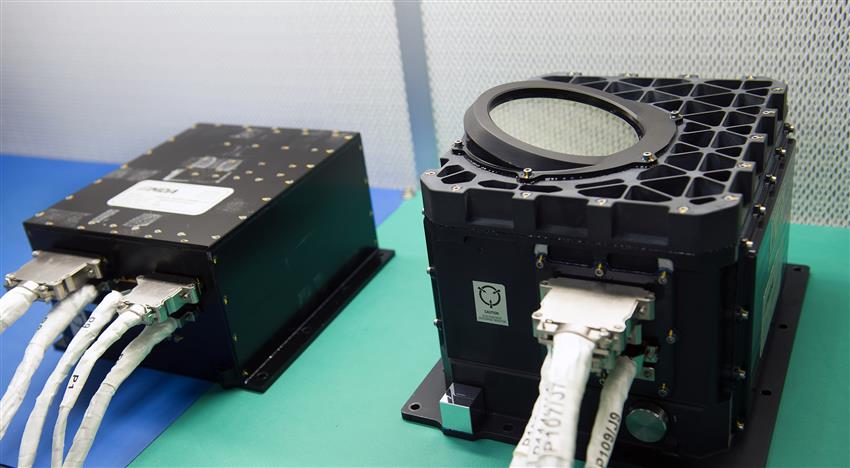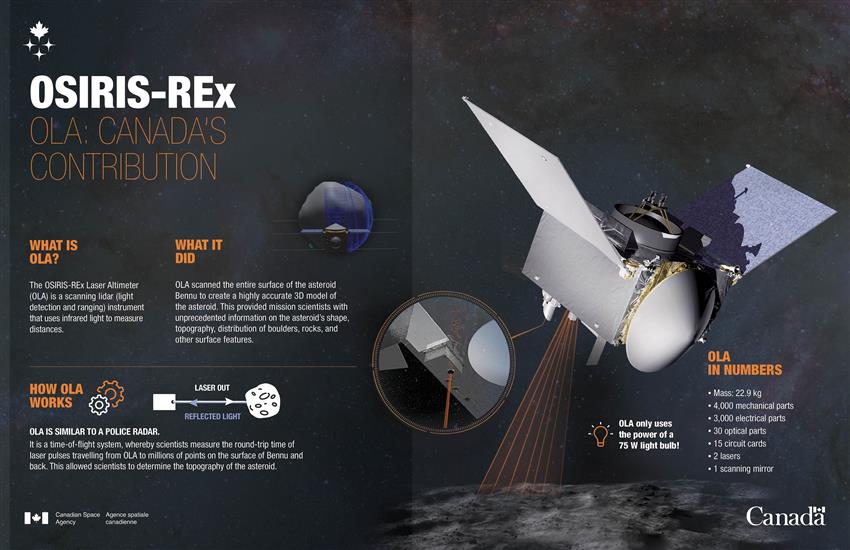Canada's role in OSIRIS-REx
Canada has a unique opportunity to showcase its technical and scientific expertise as part of NASA's OSIRIS-REx mission.
The Canadian Space Agency (CSA)'s contribution to the mission is the OSIRIS-REx Laser Altimeter (OLA), a laser system able to scan the asteroid from up to seven kilometres away. In exchange for providing the OLA instrument, the CSA will receive 4% of the total returned sample, which landed on Earth in , thus providing Canada's scientific community with its first-ever direct access to a returned asteroid sample.
The CSA also supports:
- scientists and engineers on OLA's development and operations team
- scientists from Canadian institutions who are part of the OSIRIS-REx science team
OLA: OSIRIS-REx Laser Altimeter
The sophisticated laser instrument OLA mapped asteroid Bennu. It was designed to:
- scan and measure the surface of the asteroid
- create a highly accurate 3D model
- provide scientists with detailed information about Bennu's shape, distribution of boulders, craters, slopes, and other surface features
- help researchers and mission planners select the best location from which to gather a sample of the asteroid
Tim Haltigin, Canadian OSIRIS-REx Mission Manager at the CSA, describes Canada's contribution to the mission, the OSIRIS-REx Laser Altimeter (OLA). (Credits: NASA/Goddard Space Flight Center, CSA)
How OLA worked
OLA is the most sophisticated scanning lidar to ever be used in space. It worked by:
- firing short pulses of laser light toward the asteroid
- precisely measuring the time between when those pulses of light were fired, and when they bounced off Bennu's surface and were recaptured by the sensor
OLA used two lasers:
- its high-energy laser, for scanning from 1 km to 7.5 km above the asteroid
- its low-energy laser, for rapid imaging 225 m to 1 km above the asteroid

OLA consists of two parts: an electronics box (left), which stores collected data; and the sensor head (right), which houses two lasers that fired short laser pulses and a receiver to capture the beam that bounced back from the surface of asteroid Bennu. (Credit: NASA/Goddard Space Flight Center/Debora McCallum)
Scientists used OLA's 3D map to narrow down potential sample areas on asteroid Bennu. OLA data helped answer the following questions:
- Can OSIRIS-REx access the site?
- Can the spacecraft operate at the site without being damaged?
- Is there enough loose surface material to collect?
- What scientific questions can be answered by sampling at this location?
From four potential sample sites, Nightingale was eventually selected. OSIRIS-REx collected a sample from this area on Bennu on .
This 3D global map of asteroid Bennu's topography was created from about 20 million measurements taken by OLA, an instrument contributed to the international sample-return mission by the CSA. The colours represent the distance from the centre of Bennu: dark blue areas lie approximately 60 metres lower than peaks indicated in red. This model has a resolution of approximately one measurement per metre. Image creation: Michael Daly, Centre for Research in Earth and Space Science, York University. (Credits: NASA, University of Arizona, York University, MDA, CSA)


Dr. Michael Daly (left), OLA lead instrument scientist and professor at York University, and Dr. Jeff Seabrook (right), deputy instrument scientist. (Credits: York University, Dylan Hamm, Photos Unlimited LLC)
OSIRIS-REx: a far-out opportunity for Canadian experts
OLA development and operations team
OLA was built for the CSA by MDA with significant contributions from subcontractor Optech.
This instrument is a hybrid of two other MDA technologies: the lidar on the CSA's weather station aboard the Phoenix Mars Lander, and an instrument flown on the US Air Force eXperimental Satellite System-11 (XSS-11).
OLA's lead instrument scientist is Dr. Michael Daly of York University, an expert on lidar technology and former member of the Canadian Phoenix Mars Lander team. He is assisted by:
- Dr. Jeff Seabrook, York University
- Dr. Olivier Barnouin, Johns Hopkins University Applied Physics Laboratory
These scientists, working together with instrument support engineers from MDA planned science observations, operated OLA and ensured the health of the instrument. The CSA managed overall OLA operations.
For decades, scientists have studied meteorite fragments recovered on Canadian soil and elsewhere. But when meteors enter our atmosphere, they are exposed to extreme temperatures that bake away some of the key clues scientists have long searched for.
Analyzing the pristine sample returned by OSIRIS-REx could refine our understanding of the solar system's history, how our planet formed, and possibly the origin of water and life on Earth.
Scientists from Canadian institutions
Researchers from around the country were selected to perform investigations to help unravel Bennu's physical, chemical, and geological mysteries. The CSA has provided support to several Canadian institutions.
| Type of project | Researcher | Institution | Summary |
|---|---|---|---|
| Sample analysis | Dr. Michael Daly | York University | Will develop thermal measurement techniques to investigate the sample and assess other techniques to quantify micro-scale properties of chondrites meteorites (stony meteorites). |
| Dr. Dominique Weis | University of British Columbia | Will analyze the sample to determine its origin and history. | |
| Dr. Edward Cloutis | University of Winnipeg | Will apply laboratory techniques to examine the sample's composition and compare it to data collected from the spacecraft. | |
| Dr. Alan Hildebrand | University of Calgary | Will examine physical properties of the sample to better understand Bennu's geology. | |
| Curation of the Canadian sample | Dr. Kim Tait | Royal Ontario Museum/University of Toronto | Using existing meteorites, is helping determine the methods and protocols for curating the sample and is providing petrologic and mineralogical expertise to the science team. |
| 3D maps analysis | Dr. Catherine Johnson | University of British Columbia | Used the shape of craters to study Bennu's interior structure. |

